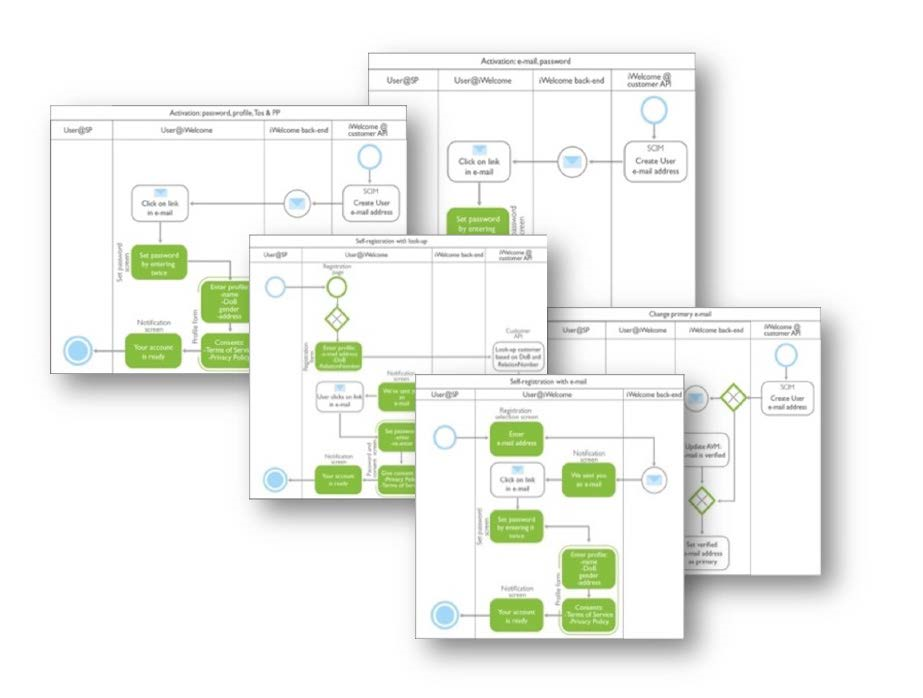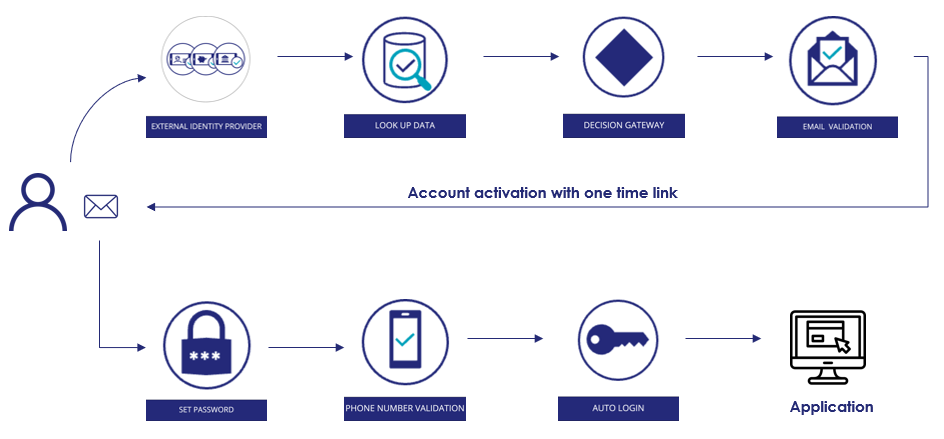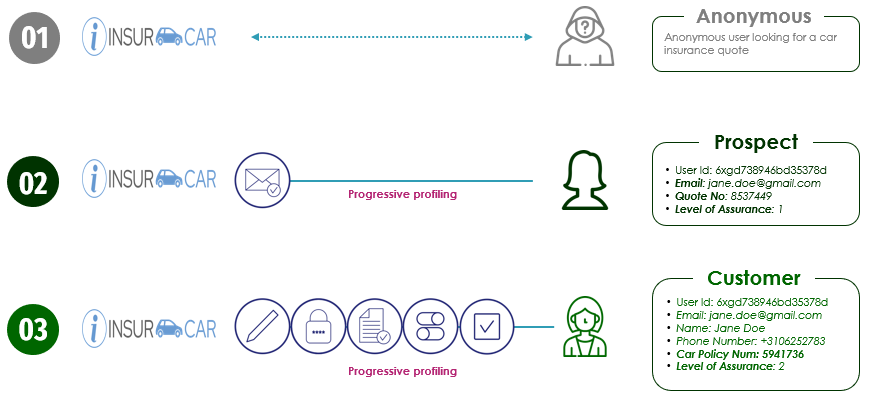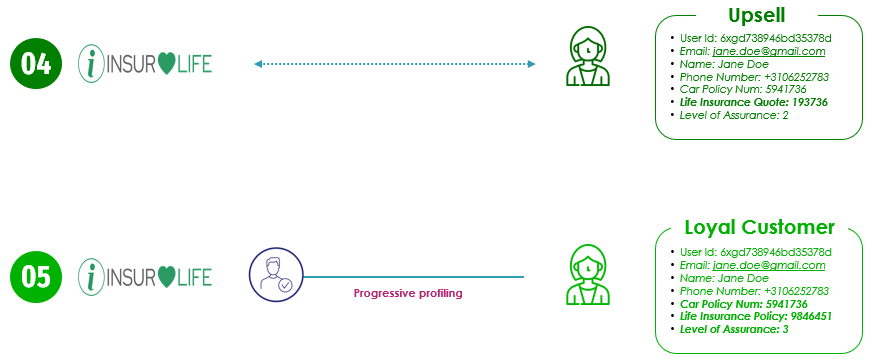User journey orchestration
User journey orchestration is a key feature of Customer Identity and Access Management (CIAM) solutions. It enables businesses to create seamless, engaging, and personalized experiences for their customers by automating the entire customer journey from registration to authentication and beyond. By automating key parts of the customer journey, businesses can improve efficiency, reduce costs, and drive revenue growth.
The true value of user journey orchestration is the flexibility to create and optimize user journeys that allow your organization to implement multiple registration flows for brands and channels. As innovations become available through the platform, organizations can quickly adopt them. For example, if a new digital wallet becomes popular in a specific region, organizations might decide to leverage this technology for fast registration. The new registration process has better conversion rates, and organizations decide to use it for multiple brands.
Key features of user journey orchestration
In the OneWelcome Identity Platform, the user journey orchestration module provides configurable flows for identity creation, identity and attribute collection and validation, and invitation and activation management.
User journey orchestration allows for modelling interactions such as registration, validation, authentication, progressive profiling, and consent across the user lifecycle.
User journey orchestration enables you to tailor authentication experiences for specific groups, such as consumers, partners, and guests. The ease-of-authentication for users and secure authorization from the OneWelcome Identity Platform combine to provide users with easy access to protected resources.
With user consent, the OneWelcome Identity Platform collects detailed information to facilitate the delivery of personally relevant messages, products, and services to enhance users' experience and engagement. User behaviors are continuously recorded, updated, and validated in identity-related attributes.
Here are some of the key features of user journey orchestration in the OneWelcome Identity Platform:
-
Registration: Enables businesses to design custom registration workflows that are tailored to their specific needs. This includes capturing user data, validating the information provided, and automatically creating user accounts.
-
Authentication: After a user registers, user journey orchestration can be used to enable various authentication methods such as multi-factor authentication, social login, and passwordless login. This ensures a secure and seamless login experience for the user.
-
Profile management: Businesses can allow their customers to manage their own profiles, such as updating their personal information, managing their preferences, and viewing their purchase history.
-
Authorization: Allows businesses to create custom authorization workflows that define what users can access based on their role, group membership, or other criteria. This ensures that users can access only the information they need while also maintaining security and compliance.
-
Customer engagement: Businesses can automate customer engagement workflows based on user behavior, preferences, and other data. This includes personalized recommendations, targeted marketing campaigns, and other forms of communication that help businesses build stronger relationships with their customers.
The identity lifecycle journey of a user
The OneWelcome Identity Platform provides building blocks to help you create an onboarding journey, such as:
- Email Validation
- Phone Number Verification
- Set Password
- Look Up Data
- Collect & Update Document Consent
- Collect & Update Attribute Consent
- Decision Gateway
- Collect User Data
- Account Linking
- Social IDPs
- External Identity Provider
- (Intelligent) Profile Completion
- Duplicate Check
- Auto Login
- Mobile App Enrolment
- Show Information

Phases in the user journey
The user journey refers to the identity lifecycle. In all cases, users follow a unified process, where they are validated, access services, and leave.
Configure user journeys for specific groups. Broker the entire journey so that users interact only with trusted resources and can focus on great services.
Joining a service
Some login options configured for the user, such as push, QR code, and OTP, display only if the user enrolled their mobile device. Ensure that you customize the user journey for registration with the desired authentication policy.
Configure the OTP text and voice messages according to the brand and language that are relevant to the user.
Using a service
-
Single sign-on (SSO): User can use one set of credentials to access multiple apps and services.
-
Re-authentication: Required if the SSO session times-out, the session terminates, or the user attempts to modify sensitive data.
-
Step-up authentication: Required if access policies demand additional credentials before a user can access protected resources.
Example user journey
The following is an outline of a typical user journey:
-
The user successfully logs on to an external identity provider.
-
The OneWelcome Identity Platform verifies the data against the policy.
-
If the user has a valid, active account on the OneWelcome Identity Platform, the authentication process continues.
-
The OneWelcome Identity Platform sends an account-activation email to the user.
-
The user selects the link in the email and sends the password.
-
The user validates the phone number.
-
The OneWelcome Identity Platform automatically logs the user in to the application without requiring the user to log in again when the account is activated.

Sample sites
The OneWelcome Identity platform webpages are responsive. Visit our example sites to see how our pages and UI elements react to different screen sizes and user interactions:
- InsurGroup is a user interface (UI) for employees of a fictitious company (tenant). It also provides links to the customer-oriented UIs for its various brands:
- RoadHelp is a UI for a different fictitious company. RoadHelp is a tenant with one brand of the same name.
Progressive profiling
Progressive profiling enhances a user's experience by collecting just enough data, just in time to ease their purchase of multiple products. Over time, you build up on the data you collect about a consumer without the process being invasive, keeping it straightforward and frictionless.
The following sample flow shows how the OneWelcome Identity Platform's identity-first approach makes it easy for InsurGroup to up-sell to Jane if she already has a product from the company. In this example, car insurance and life insurance can be sold by different business units.
-
A user browses for car insurance and enters the make and model of their current car.
-
The user receives a quote. Up to this point, the user is anonymous. You do not know who this user is. The system doesn’t know either. The user is an anonymous person browsing the web page and making some calculations

When this user receives the quote, they might think that it is a good quote, and want to save it so they can revisit and review the quote again to make a decision later on. The user becomes a prospect, a potential user who can buy car insurance. The insurance company would not want to overwhelm the user by collecting a long list of data. If, at that point in time, they ask for the email, name, last name, and password, that would be too much. You can have a very lightweight journey that captures the minimum information required to create an account for this prospect, so that this prospect can return and read that quote multiple times before buying the insurance policy. From an anonymous person, you now have a prospect.
-
The example customer, Jane, likes the quote and returns after a week, and now she wants to buy the car insurance. She now becomes a customer. As the company, you might need more information about Jane to prepare a car insurance contract for Jane. That is a step-up registration, which means she now goes through a user journey to provide only the missing data elements or missing data attributes required for the company to prepare the car insurance in her name.
-
Jane has purchased the car insurance and has been a customer for six months. Now she starts looking at life insurance options. Having purchased her car insurance from InsurGroup, she is interested in the quotes they provide for life insurance. Jane browses the life insurance portal, makes some calculations, and gets a quote. At this point InsurGroup does not ask Jane to create a new account. It can reuse Jane's existing account for this transaction. This is where up-sell takes place.
-
Jane returns a few weeks later. She likes the life insurance quote and purchases the life insurance. Again, to prepare a life insurance contract, the insurance company might need more information than when designing the car insurance policy. A step-up registration takes place. We see that over time, this consumer moves from an anonymous user to a loyal customer.
Progressive profiling data model
This section describes the previous progressive profiling example in terms of the data model. The user goes through the workflow in a frictionless way.

-
An anonymous user accesses an organization's product-offerings website.
-
Progressive profiling begins. When the user saves a quote, they are asked to provide their email address. An account is created for the user. The account contains a user ID, an email, and a quote number. The level of assurance is minimum.
-
The anonymous user attempts to make a purchase. They are prompted to provide personal information, set a password, and provide consent. Based on this additional information, a car insurance policy is created. The account now includes a name, a phone number, and a car insurance policy number. The level of assurance is increased.
-
When the user requests a quote for another product, they can reuse the same account. The account is updated only with a product quote.

-
The user proceeds to purchase the product. Progressive profiling continues with just one step, such as digital verification of their identity in real time. The account information already includes their car insurance and life insurance policy number, so the level of assurance increases again.

